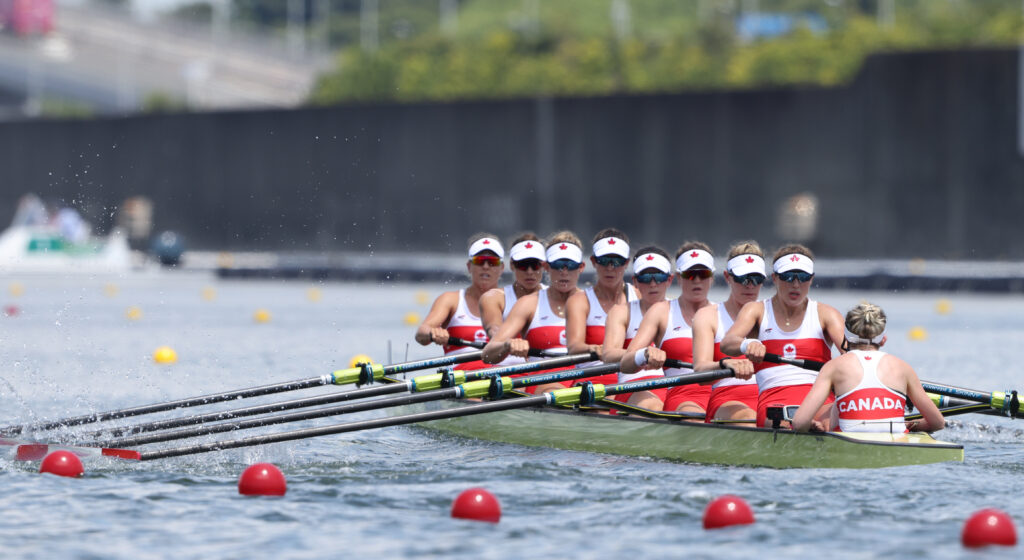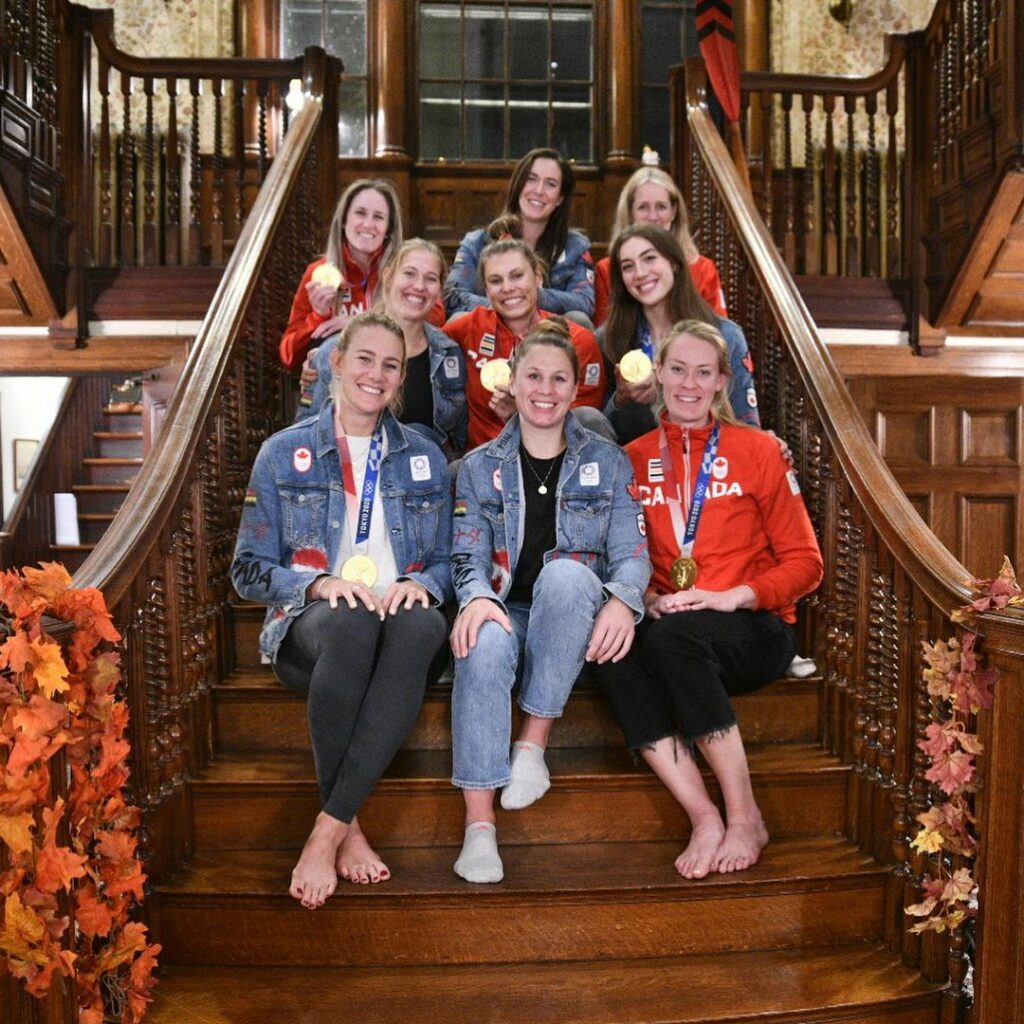
28 Oct 2021
"You miss 100% of the shots you don’t take" - 2021 Head of the Charles
Olympic champion coxswain, Canada’s Kristen Kit talks about racing in the eight at the 2021 Head of the Charles in Boston, United States.
When messages started to fly around our seven different team group chats about racing in Boston, I immediately had visions of carving our eight through Head of the Charles’ challenging course. My imagination showed me the sleek rhythm we had worked tirelessly towards and the sharp bladework I had become used to. My mind had convinced me we should do it – perhaps another gold to complement the ones so recently won in Tokyo?
Then—immediately after the Olympic fuelled vision popped into my brain– I had to consider whether I would fit into the coxswain seat at the end of October. Given my off-season ambitions this year, I had become a “pleasure athlete” at best.
As the weather cooled in Canada, our crew joined together on a virtual call for an Olympic debrief and Charles planning. To be clear—this was at the end of August, a month after racing at the Sea Forest Waterway in Tokyo. The group was excited at the prospect of joining back together and finally having the opportunity to race in front of a live crowd, something that was conspicuously missing in Tokyo.

There was a caveat to racing in Boston. We knew we wanted to enjoy the experience and therefore some training would inevitably be involved (especially since we are all highly competitive people by nature). At this point we had two of the crew members abstain from the trip, for reasons relating to a honeymoon and previous commitments. Calling up Becca Zimmerman and Morgan Rosts, our spares from the Olympics was about more than just filling the seats.
“Having trained with Becca and Morgan closely through COVID, through rigorous selection, and at training camp in Japan, it was important to the girls to include them,” Andrea Proske, 4-seat, told me. “There may be nine women on the water, but there’s an army on the shore that helped us get there. Our spares are no small part of that journey to gold.”
Fast forward through three weeks of a training programme that our wise and illustrious coach, Michelle Darvill had created. This was to help us bridge a 2km Olympic final, raced three months prior, to a 4.7km head race.
We filtered into Boston’s Logan International Airport excited to see each other and a bit less excited to actually race 4.7km after varying levels of commitment to the aforementioned workout plan. We were hosted by the mother of local legend and Bermudan single sculler Dara Alizadeh. Elizabeth Alizadeh, or “Saint Elizabeth” as she quickly became known as, welcomed us with open arms offering us beds, food and hilarious stories from her lengthy connection to the rowing community.
The first night set the tone for the weekend with three-time Canadian Olympian and former University of Washington rower, Conlin McCabe putting words to how we were feeling about our impending race.
“I’ve brought Wayne Gretzky’s 2020 Merlot vintage to celebrate the women’s eight. I picked this wine because of the similarities at this regatta. Wayne Gretzky (professional ice hockey player) is the Great One, similar to your eight from Tokyo. But his wine is widely accepted as not great… similar to your eight at this regatta. Cheers!”
We wholeheartedly agreed with this assessment, as we hadn’t rowed together since July 30th and some hadn’t touched a boat since.
Although the race plan on the water was yet to be decided, the plan off the water suddenly became clear – a chance to spend time together, further tightening the bonds of our sisterhood, sharing our stories we never had the chance to talk about in Tokyo before leaving 24 hours after our race and, most importantly, lighting the fire for Paris 2024.
Friday midday we arrived at Harvard’s Newell boathouse. Thanks to the goodwill of many alumni we were loaned an Empacher shell and oars. The process of getting ready for a row as a team is something we often never think twice about and, in a way, take for granted. It’s our job to train 2-3 times a day, six and sometimes seven days a week. As we stashed our bags in Newell’s boat bay, we once more got to do a simple task that we hadn’t done for three months.
Then it was down to the business of dusting the rust off. I squawked out a call to the women to push off before realising that some weren’t ready yet. Whoops. Classic novice coxie mistake. Sorry ladies. One person told me the volume was too loud, another said the volume was too quiet on the cox box. Suddenly, I felt like no time had passed since our last outing in Japan.
No matter how many times you race the Head of the Charles, it’s always a magical experience. 2021 did not disappoint.
For the first of two rows we got to participate in the chaos and excitement of the river on practice day. Personally I was on a reconnaissance mission. I was curious as to my ability since it had been three years since I last steered the course. The women were fantastic; they worked on the rhythm while I worked on my lines (as well as not hitting the several coxed fours rowing by pairs under Weeks and Anderson bridges.) As a non-Boston resident, I knew I was going to need to be very focused on race day.

Sunday morning dawned cold but sunny—a perfect day to toe the battle line again. While we may have been lacking fitness and boat time together, we were enlivened to race the championship women’s eight. It’s an honour to wear the Canadian maple leaf at the Head of the Charles, and we were still going to put ourselves in the hurt locker.
As we pushed off from Newell, the nerves electrified the air. While we inched our way up to the basin, the crew was positive. The boat actually felt ok—maybe the ‘Great Ones’ could make a comeback?
After a windy loop in the warm up area we began staging. We were in third position in the starting line up. At the Head of the Charles, boats are sent off in a time trial format, with no time gap published – just “around three boat lengths” between eights. I’ve always had an immense amount of respect for the umpires who have to marshal several hundred crews to a start line, three days in a row, in often adverse and windy conditions – meaning it’s hard to hear instructions.
Our own start went perfectly. We went through the first bridge, which happens to be a series of bridges close together, sharing abutments. The wash and wind going through the bridge was manageable, though noticeable. We got onto a decent rhythm, then as we went into Deadman’s Turn, the wheels started to fall off.
Uh-oh.
To put things into perspective we were about 1km into the race.
It should be apparent now that our fuel tanks ran out. The women valiantly pushed into every call I made. The level of gratitude a coxswain feels for a crew who trusts her is immense. I just wish the legs could have lasted for more than seven strokes.
As we proceeded down the course deep into the race, it was the crowd who kept us going. The excitement and spirit of the Head of the Charles regatta is like no other and it was alive and well at the 2021 edition. A particular shout out goes to the fans who draped a massive Canadian flag over Eliot Bridge. Seven-seat, Sydney Payne disclosed after the race she didn’t remember much of it, but she distinctly remembered smiling for ten strokes once she saw the homage to our country.
After crossing the finish line, the women got over the initial shock of the feeling of blood in the lungs and began to enjoy the atmosphere again. We were met by one of our supporters, Portland-based rower Ned McCall, who brought us some Japanese-inspired recovery beverages. On our row back up to Newell, we traded congratulations with the other crews and soaked up the applause and cheers from the shoreline – a fine substitution for the atmosphere we missed in Japan.
Rowing is one of the most gruelling sports to train for. This was a sobering reminder of how there are no laurels to rest on. As the feelings of disappointment faded with every sip on the row back, I found them replaced instead by gratitude – for our high performance manager, Adam Parfitt from Rowing Canada Aviron and to our coach Michelle who, although she would have liked us to place higher, she saw the value of bringing the group together to begin building for Paris 2024.
For Head of the Charles results: https://www.hocr.org/

